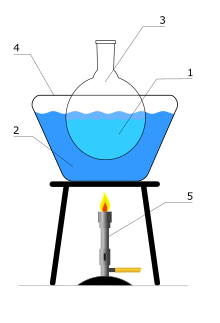water bath
A water bath is a container filled with warm or hot water , in which there is a vessel with a substance to be heated. Water baths are used in the preparation and storage of food, in the pharmacy for melting ointment and suppository bases and for heating substances in chemical laboratories .
preparation of meals
In the water bath you prepare meals that should not have direct contact with the water as a heat exchanger, so that they are not watered down. These are often puddings such as Christmas pudding or blood pudding . Also, souffles and egg custard prepared that way. To do this, you fill the base material into a metal or porcelain mold and place it in a vessel filled with water. This is then heated on the stove or in the oven to cook or stop the food.
Hot steam is generated over a water bath , which is also used to prepare food. Warm whipped sauces such as hollandaise sauce or béarnaise sauce are typical . The steam is also used for the production of basic masses in the confectionery and ice cream making. You hold a metal vessel over the steam and heat it slightly. In this there is a seasoned egg mass, which can be prevented from sticking by constantly beating. The air that is lifted in creates a light foam that is later combined with fat and starchy foods.
Cooked and scalded sausages such as Bockwurst , Knacker and Viennese sausages are heated in special sausage kettles before consumption.
Keeping food warm
A bain-marie is often used to keep food warm , a device in which vessels with food are placed on a sieve above the water. Due to the temperature of max. 80 ° C and the lack of contact with the heat source, the quality of the food is retained for a long time, but the cooking process is not continued. It is widely used in soups , side dishes , sauces, and other delicate foods.
For the heating of pasta to use screens , comes through the hot water directly to the food contact. Meat products such as roulades and roasts, on the other hand, are heated in broth or stocks . For fish, poultry and other sensitive dishes, however, the process is only suitable for warming up, not for storage, as otherwise there will be a significant loss of quality due to decay or loss of taste.
Use in laboratories
Water baths for heating up to 100 ° C can be used universally in the laboratory . Because of the high heat capacity of water and the resulting inertia, they are well suited for exceptionally accurate automatic temperature control. Water baths are widely used in biological and chemical laboratories.
See also
literature
- Erhard Gorys : The new kitchen dictionary . 11th edition. dtv 36245, Munich 2007, ISBN 978-3-423-36245-0 .
- Collective of authors: Food theory . 2nd Edition. VEB Fachbuchverlag, Leipzig 1989, ISBN 3-343-00303-4 .
Individual evidence
- ^ Organikum , Wiley-VCH Verlag GmbH, 23rd edition, 2009, p. 15, ISBN 978-3-527-32292-3 .
